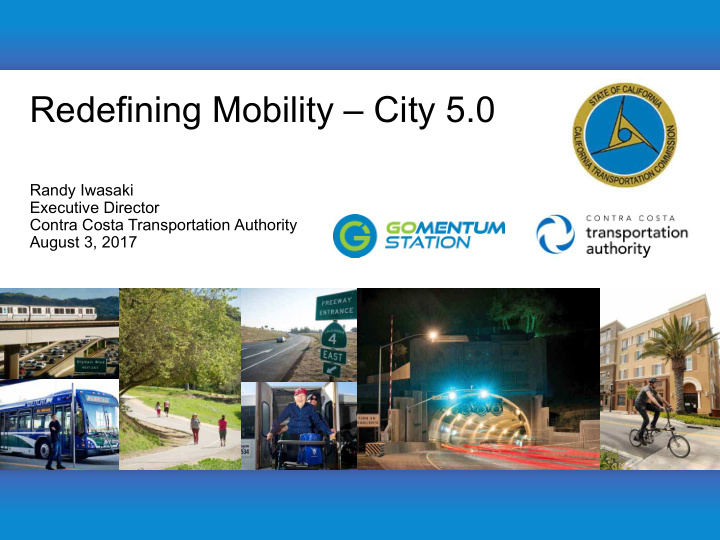



Redefining Mobility – City 5.0 Randy Iwasaki Executive Director Contra Costa Transportation Authority August 3, 2017
WHO WE ARE • The Contra Costa Transportation Authority (CCTA) is a public agency formed by Contra Costa voters in 1988 to manage the county’s transportation sales tax program and to lead the county’s transportation planning efforts. Who We Are • CCTA is responsible for maintaining and improving the county’s transportation system by planning, funding, and delivering critical transportation infrastructure projects and programs that connect our communities, foster a strong economy, increase sustainability, and safely and efficiently get people where they need to go.
WHAT WE DO • BUSES- Invest in a reliable, comfortable and • BICYCLE - Invest in safe routes and convenient bus network infrastructure improvements for bicyclists LOCAL STREETS- Smooth traffic flow on • • BART- Make improvements to BART service major roads and invest in neighborhood and stations, such as extensions to new improvements such as repairing potholes and routes and parking at stations road surfaces • HIGHWAYS- Complete Contra Costa’s • PEDESTRIAN - Make improvements to highway system, and improve air quality and sidewalks, crosswalks, trails, and paths noise protection along these corridors • SAFE ROUTES TO SCHOOLS- Focus on • CARPOOL/RIDESHARE- Implement programs aimed at reducing traffic programs and projects aimed at bicycle and pedestrian safety for K-12 students congestion by encouraging carpooling and ridesharing • FERRIES- Expand the Bay Area ferry system by looking to ferries as an alternate commute • PROGRAMS FOR SENIORS AND PEOPLE method between West County and San WITH DISABILITIES- Enhance transit Francisco options to improve mobility for seniors and people with disabilities 1
Transportation Planning
Regional Transportation Planning Committees • Four Distinct Sub- regions • Responsible for prioritizing local projects and programs • Develop Action Plans for Routes of Regional Significance
Long Range Planning – The Countywide Transportation Plan • Updated Every 4-5 Years • Documents the Authority’s Goals, Vision, and Strategies • Action Plans are Developed by the Regional Committees • Includes 10- and 20-Year Financially Constrained Project Lists
Travel Demand Forecast Modeling • Used to determine impacts of land use developments and transportation improvements through year 2040 • Model assumes increased capacity of existing roadways due to automated/connected vehicles • Accounts for clean vehicle deployment over time • Model provides future forecasts of GHG emissions, Vehicle Miles Traveled and Vehicle Hours of Delay under various scenarios
Implications of Urban Mobility Planning 50% 6% Consider explicit Consider impact recommendations of driverless car of or new highway technology construction 12% 3% Consider no new Consider impact highway of Uber and Lyft construction 20% Consider impact of roadway diets Source: League of Cities
Climate Change and Transportation • Authority’s plans build upon California’s strong GHG emission reduction policies • Includes accelerated clean vehicle deployment and automated vehicle technology
Introducing the GoMentum Station Program Connected Vehicle and Autonomous Vehicle (CV/AV) Program and Test Facility U.S. Department of Transportation Automated Vehicle Proving Ground i
WE ARE GLOBAL i
STATION PROGRAM Overarching Goals ECONOMIC GROWTH & JOB CREATION 21 ST CENTURY TRANSPORTATION EFFICIENT MOBILITY ENHANCED SAFETY HEALTHIER ENVIRONMENTS
GoMentum Station More than 5,000 acres with 2,100 acres currently available for testing
GoMentum Station
Honda Research Institute
Otto - Uber Freight
Baidu
EasyMile Shared Autonomous Vehicle Project
SAV Partners
Program Phasing and Schedule Procurement, Legislative Approval Bench Testing, Field Operational Testing and Regulatory Approval SAV Arrival in Contra Costa B C A 2016 2017 2018/2019/2020 SAV Delivery, Testing in Confined Commercialization and Deployment area of Public Road at Bishop Ranch In Contra Costa County Phase – III Phase (Contra Costa (GoMentum County) Station) EasyMile SAV EasyMile SAV
Phase I – SAV Testing Plan
Phase II – SAV Testing Plan Phase II (a) Confined Environment of Bishop Ranch Phase II (b) Public Roads of Bishop Ranch
Phase III – Implementation
Impacted Industries i
GoMentum Station CV/AV Program • Insurance • Parking lots • Auto Repairs • Fast Food • Professional Drivers • Gas Stations • Hotels • Real Estate • Airlines • Media • Auto Parts • Auto Industry • TNCs • Public Transit https://www.cbinsights.com/blog/13-industries-disrupted-driverless-cars/ 40
How to prepare for the future! i
• Education & Outreach • Planning Process • Engagement • Flexibility • Leverage • Consistency • Collaboration • Partnerships
CCTA CV/AV Program Thank you! Randy Iwasaki (925) 256-4724 riwasaki@ccta.net @riwasaki2
Recommend
More recommend